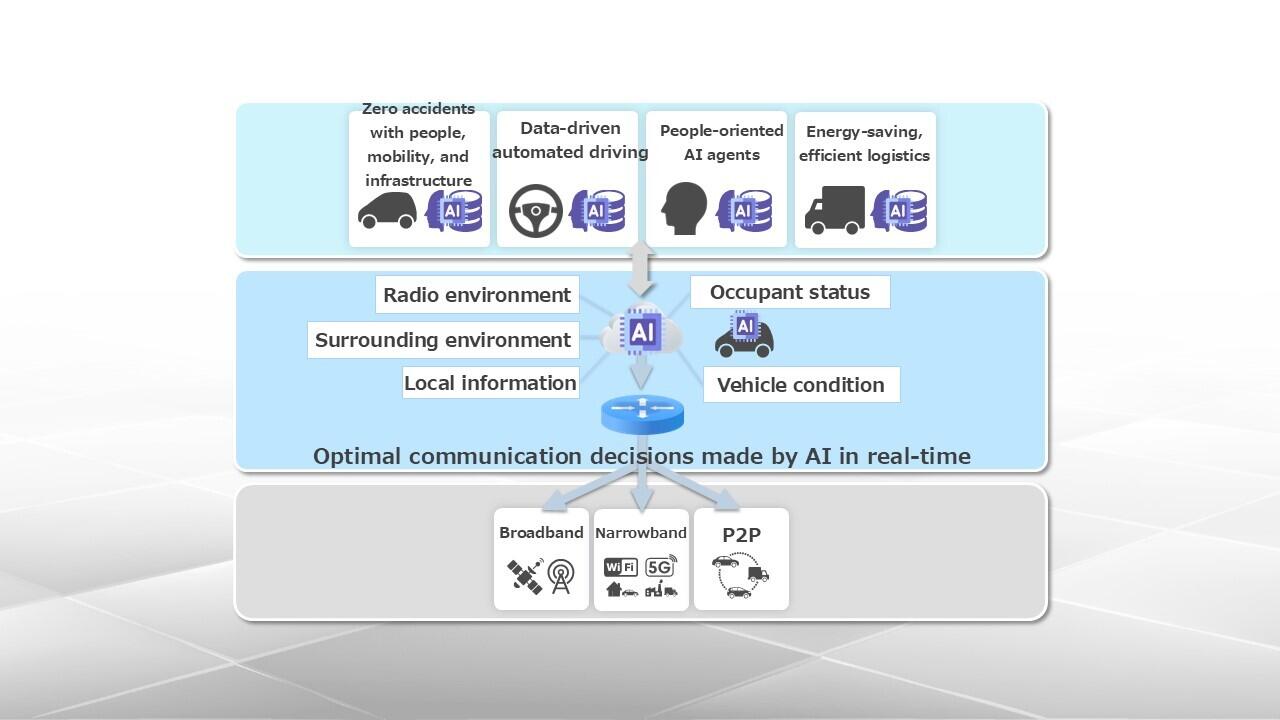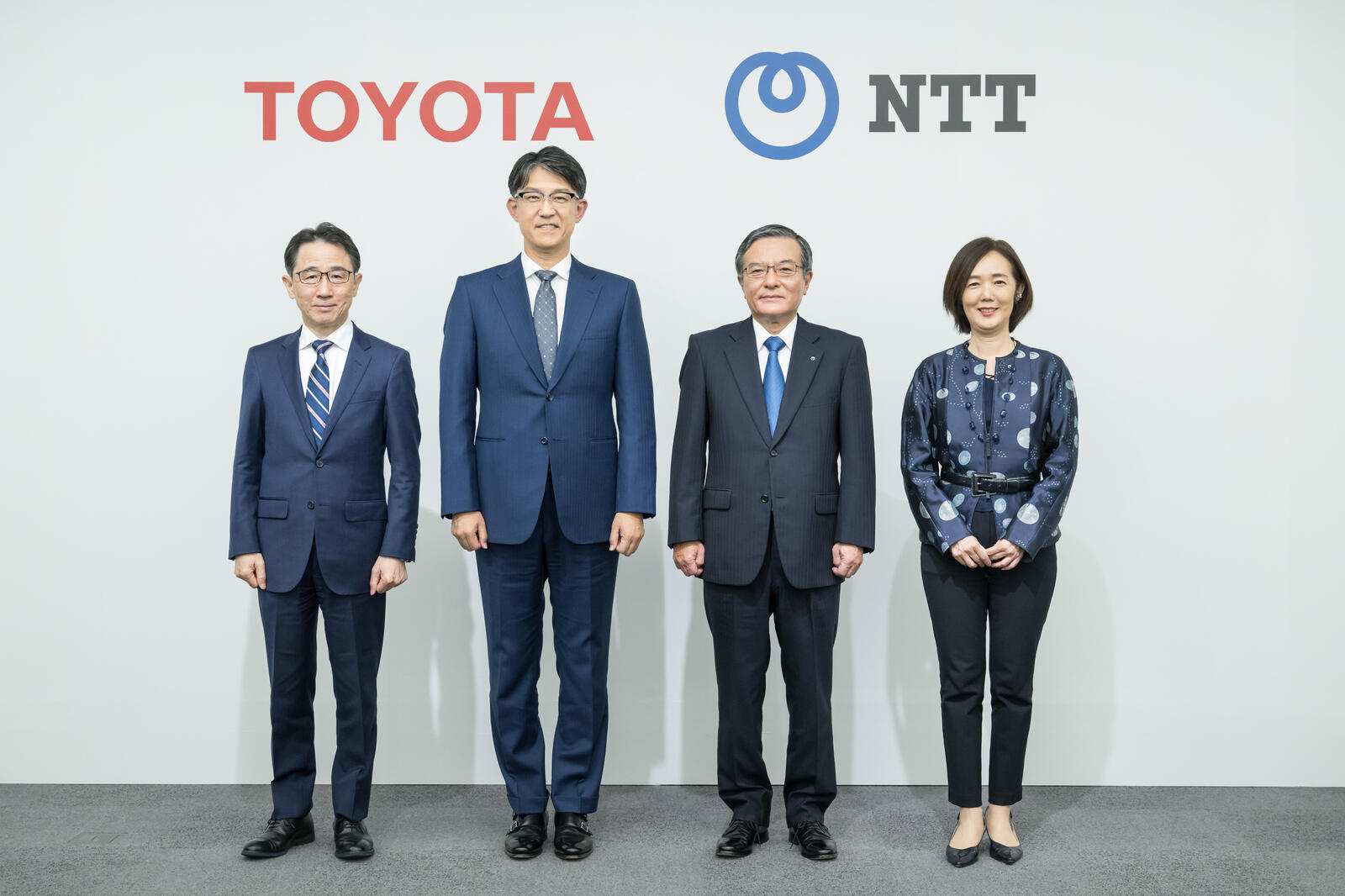
NTT and Toyota have taken a new step toward realizing a "society with zero traffic accidents" by working together to build a Mobility AI Platform.
Automated driving, a means to an end
For the Q&A session, the two presidents were joined by NTT Executive Member of the Board Sachiko Onishi and Toyota Senior Fellow Keiji Yamamoto. The questions covered topics ranging from automated driving to collaboration with other carmakers.
Automated driving was mentioned as part of this joint initiative, but what are Toyota’s views on the technology?
President Sato, Toyota
Automated driving is merely a means to an end, which is creating a safe and secure mobility society. We regard it as one method for establishing a three-pronged environment.
We are a carmaker, so even when considering automated driving, our unwavering stance is to remain people-centered.
That is, rather than entrusting the operation of vehicles entirely to the environment and infrastructure, our approach is to build an environment that is always centered around people.
Securing freedom of mobility in this way is the path we need to pursue.
However, that goal cannot be reached in a single leap, and we should not set our targets in terms of achieving certain levels.
If we take a people-centered approach to automated driving, I believe our KPI will be how well we can create a safe, secure driving environment.
Since the ideal scenario is not something we can reach quickly, it will be a matter of steadily continuing to eliminate cases one by one.
As part of that process, advanced driving support will improve, bringing automated driving out into the world. That is how we want to approach the technology.
What do you see as the challenges in reaching zero traffic accidents?
President Sato, Toyota
Although the total number of accidents is declining year by year due to advances in technology, as the graph shows, the rate of decline has reached something of a saturation point.
If we are to try and lower the accident rate further, we must enlist technology in anticipating risks. We need to shift from a passive approach to actively incorporating various predictions.
We feel that being able to develop many different technologies together will be extremely beneficial.
You explained that the plan is to start offering the platform to partners around 2028 before expanding globally, but specifically, what kind of companies and institutions do you envision using it?
President Sato, Toyota
If we return to the overview of the platform we are trying to create, it looks something like this.

In the center, we will build an environment that enables “optimal communication decisions made by AI in real-time.” This is an area where NTT and Toyota will dedicate much effort, yet it is not the complete picture.
On top of that, we need to consider ways of integrating various services through the AI platform.
In this domain, we will seek to create value by open-mindedly approaching potential companies without waiting for 2028.
I believe this is actually an area of competition. What services will each company come up with? And how do we build the ideal AI platform to facilitate them? This will likely be one arena of competition.
On the other hand, the platform we are pursuing with NTT and Toyota will begin as a collaborative area. Together, we will lead the way in establishing a communication environment, with other companies coming on board where possible.
Below that, in the telecommunications domain, we have many different operators. Working within this framework, we need to keep approaching more companies to create the overall picture.
Are you considering providing these services to other carmakers besides Toyota?
Senior Fellow Yamamoto, Toyota
We want to make this communications format a standard not just in Japan, but across the globe. We anticipate it being used by other carmakers beyond Toyota.
President Shimada, NTT
I think it is important to grow the business gradually with those who share our values.
Given that a sudden global expansion is not possible, I feel it is best to begin by partnering based on shared values.
Four and a half years after NTT’s then-President Sawada and Toyota’s then-President Toyoda announced a capital alliance, the focus has broadened from cities to society—how did this come about?
President Sato, Toyota
The collaboration reached a major inflection point in 2020.
Under President Toyoda and NTT’s President Sawada, our companies believed that pursuing various initiatives with the concept of integrating mobility into society would help make a safer world.
This broad vision arose at both companies around 2020, and it has spurred various efforts within our business operations.
Since then, both the telecommunications and mobility environments have changed significantly in the past few years. In a sense, the time is now ripe.
I believe the most important aspect is purpose. What are we doing this for?
Looking at the state of traffic accidents, I don’t think we can yet say the numbers have declined.
We have a very strong sense that there are limits to what autonomous mobility alone can achieve in creating greater safety and security.
With a shared purpose, NTT and Toyota are working together to generate ideas toward the same goal. Although we do not yet have the right answers, there is growing momentum to start by trying various initiatives.
I think that was the biggest driving force leading to this announcement.
Many challenges still remain, and the story is far from straightforward—there will be difficulties and much agonizing, but the key is that we have a shared image of the all-important end goal. We appreciate your understanding and support.
President Shimada, NTT
Around six months ago, we decided to take another step forward and began discussing what form that would take. The results of those discussions led us here today.
Even before 2020, Toyota and NTT had built up a track record of various tests and trials, including simulations for connected cars.
I see this as an indication of our shared mindset in pursuing our vision. We hope you will continue to follow our efforts.


